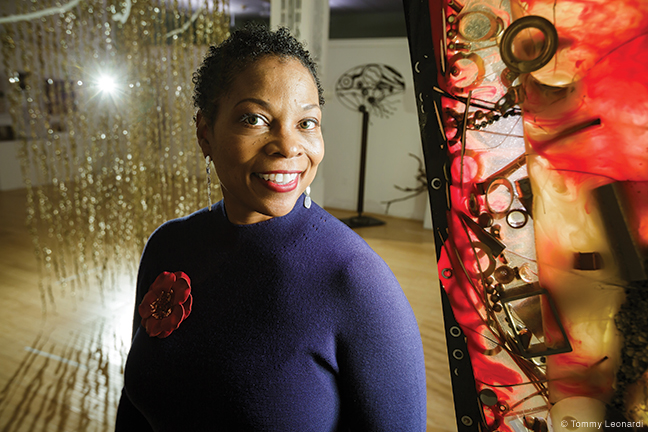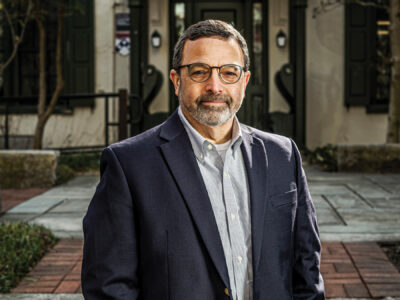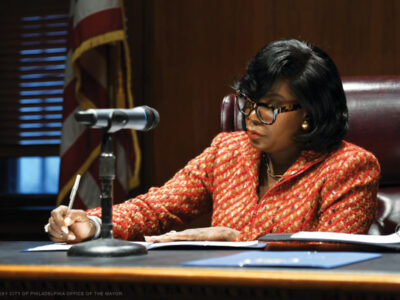
Philadelphia’s Chief Cultural Officer wants to “make sure that we service the entire city.”
If you venture into the Office of Arts, Culture and the Creative Economy in Philadelphia’s City Hall, look up: There’s a flock of metallic birds overhead. A teddy bear of puffy cotton encased in wire sits nearby. Hanging on a wall are mixed-media assemblages—featuring a deconstructed trombone and black boot polish—that evoke 19th-century trompe-l’oeil still-life paintings.
These imaginative sculptures, in the exhibition “Ethereal/Material,” are part of Art in City Hall, one of the many cultural initiatives supervised by Kelly Lee C’89. Lee herself is especially partial to a delicate golden drapery of gilded sea snail egg casings suspended from a white-painted tree branch.
“This is my favorite,” she says of Gabrielle Del Conte’s Continuance, “because of the way people interact with it.” Despite the taboo, “they can’t help but touch it.”
As Philadelphia’s Chief Cultural Officer and executive director of the Office of Arts, Culture and the Creative Economy since 2016, with an annual budget of about $4.1 million, Lee prizes that level of involvement. Under her leadership, the city has created such programs as Performances in Public Spaces and Culture in Neighborhoods to bring the arts to traditionally underserved corners of the city. That has entailed organizing and funding about 75 free performances a year, both outdoors in parks and plazas, and indoors at libraries, recreation centers, and schools.
“The mission of the office is to close the cultural gap and provide access to Philadelphians to all of our arts,” as well as to support the city’s cultural sector, Lee says. The two goals are interrelated, she points out: “If we are providing cultural opportunities for communities in neighborhoods where people live, we’re hiring artists and performers to do that work.”
An Arts Access Calendar and weekly email blasts alert Philadelphians to the various free events. Another initiative, an annual Arts Education Fair, connects teachers and administrators with arts organizations that provide student programming. The fairs are supplemented by ArtsLink, an online portal listing arts education opportunities.
Lee recalls attending a “really mellow” singer-songwriter concert in a West Philadelphia park, an event in the Performances in Public Spaces series. “What was really exciting,” she says, “was watching the people watch their kids get engaged with the performance—and then enjoying it with them.” As a result, she hopes that “parents automatically seek out more opportunities to bring their kids joy,” creating a pipeline for new arts audiences.
Lee grew up with three siblings in the Germantown section of Philadelphia, where her family owned a bar. (She also spent four years in Portsmouth, Virginia, after her parents divorced.) From seventh grade on, thanks to a scholarship, she attended the Germantown Friends School, a private Quaker school with a strong arts program.
At GFS, she worked on stage crew and as the chorus’s librarian, keeping track of the music. “I have no talent now—had no talent then,” she says. But she did take dance lessons: jazz, ballet, and tap. “That was my joy, my passion,” she says.
For her junior project, Lee gained work experience at Penn’s Annenberg Center for the Performing Arts. “It was my first entrance to the arts in a professional way,” she says.
At Penn, where she majored in English and minored in Communications, Lee sought out a work-study job at Annenberg, where her responsibilities included providing administrative and marketing support to the Office of Student Performing Arts and the Philadelphia International Children’s Festival. (She also worked in a movie-rental store and took on occasional catering gigs.) Among the perks of the Annenberg job were periodic free tickets to the Philadelphia Orchestra, the Pennsylvania Ballet, and professional theater.
“One of the things that was helpful to me [at Penn] was being able to juggle—being able to take classes, have two jobs, and also participate in the arts [as a spectator]. That was my norm,” she says.
After graduation, Lee held a wide array of jobs and served on the boards of various cultural organizations, from the Arden Theatre Company to the Philadelphia Museum of Art. As a volunteer, she helped fellow Penn alumni run the Philadelphia Women’s Theatre Festival, which started at the University and eventually incorporated as a nonprofit. She was business account manager for Philadelphia’s Department of Commerce, director of communications at the Pennsylvania Convention Authority, and regional director of economic and business development for PECO Energy.
“In Philadelphia, it’s two degrees of separation,” Lee says, “and one position always led to the others.”
From 2002 to 2010, she was president and CEO of Innovation Philadelphia, a nonprofit jointly funded by the city and federal grants that fostered technology-based creative businesses, such as graphic design, software development, and architecture.
“In all of these jobs we were promoting Philadelphia,” she says. “And the arts are such a big part of Philadelphia’s quality of life.”
After a shaky economy spurred the closing of Innovation Philadelphia, Lee embarked on what she calls “Kelly Lee’s favorite cities tour,” including stops in Italy, London, and Provence. When she returned, she found a consulting job at Seslia and Company, working mostly in the US Virgin Islands.
A friend tipped her to the city cultural job. “I understood the arts from the tourism point of view, from the convention center,” she says. “I understood it from the economic development point of view from Commerce Department work, PECO Energy work, and now, from Innovation Philadelphia, I understand that creative work force—so the talent part of it. So this job here is that perfect convergence.”
Every city, she says, faces similar issues on the cultural front: “Creating pipeline, more access, diversity and inclusion—everyone’s having the same conversation. I can’t think of any city that has figured it out. If they do, there’s a problem—because it’s always going to be changing. You always have to be changing to appeal to new audiences.”
In her own office, she says, her favorite object is a large map of City Council districts, adorned with a magic-marker list of City Council members. “With every program that we do, we write down where it is, and we put it up there on the map because we to try to make sure that we service the entire city,” Lee says. “So that was the first piece of artwork I put on my wall, and that’s the most important one. Because we want to make sure we’re touching every neighborhood, every community.”
—Julia M. Klein





Great article thank you for sharing this story. It is great to witness an African American Women who is also a native of Philadelphia as the Chief Cultural Officer and executive director of the Office of Arts, Culture and the Creative Economy. Great work!